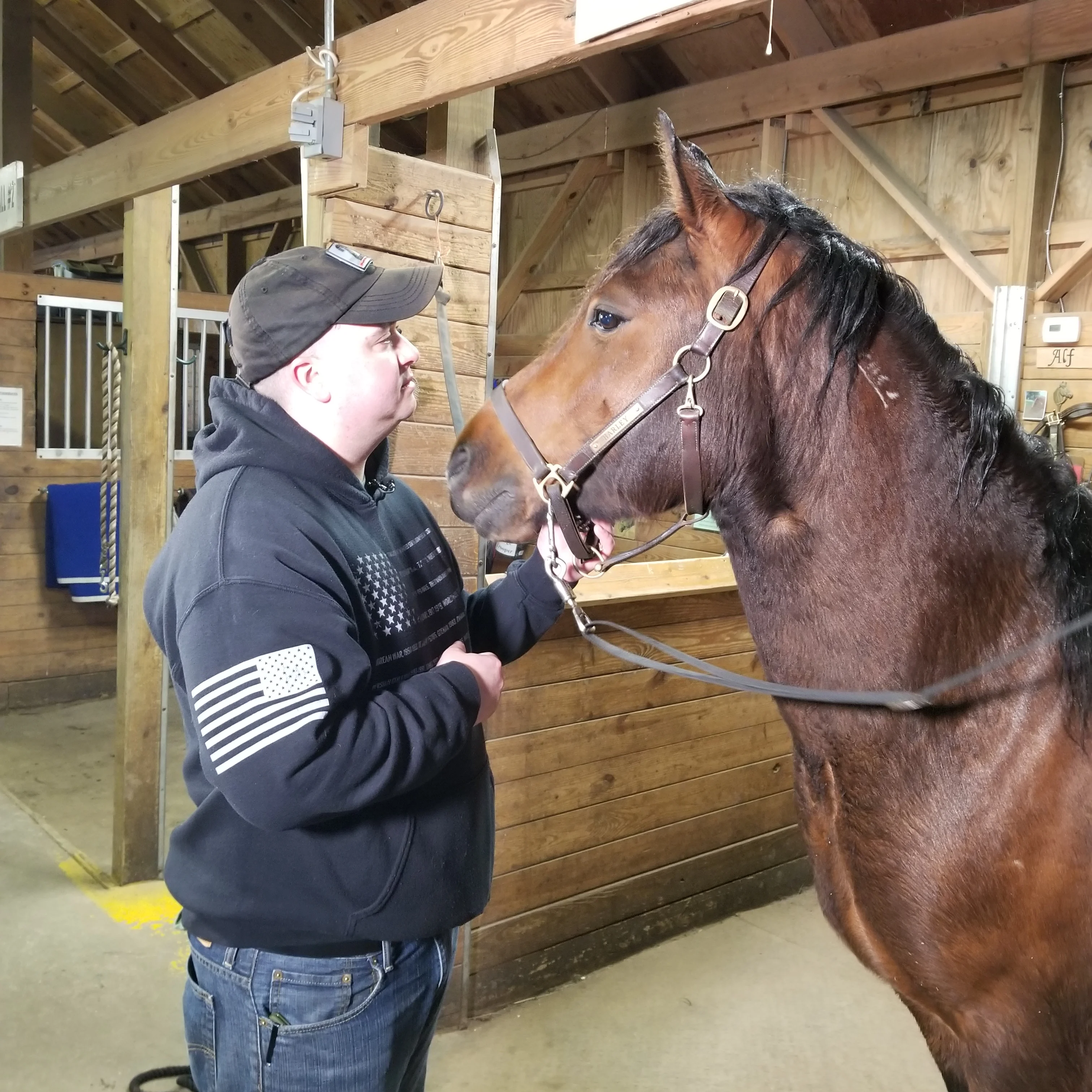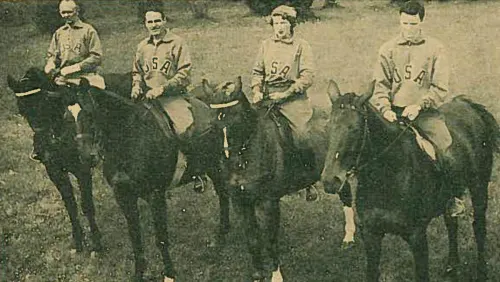When Master Sgt. Luann Van Peursem retired after 33 years in the service, she was a highly decorated combat veteran, having earned the U.S. Air Force Commendation Medal with Valor for saving the lives of two fellow airmen during an attack in Baghdad. But when she returned home, the attacks stayed with her. She couldn’t sleep, was hypervigilant, and she lost trust in those around her. Nightmares and flashbacks consumed her.
“I was very close to becoming a statistic,” says Van Peursem, of Rochester, New York. “I was contemplating suicide. Thankfully, I had an intervention through EquiCenter. From the minute I set foot on it, there was just something about it. It was like magic.”
EquiCenter, located at the William & Mildred Levine Ranch in Honeoye Falls, New York, offers diverse programming for those living with disabilities, veterans and at-risk youth. A Professional Association of Therapeutic Horsemanship International Premier Accredited Center, this nonprofit organization uses horses to heal through therapeutic horseback riding and horsemanship. The busy center also offers therapeutic horticulture, yoga, canine-assisted activities and a farm-to-table culinary program.

Master Sgt. Luann Van Peursem, U.S. Air Force (Ret.), with mustang Ranger. Photos courtesy of Mission Mustang.
As the center grew, Jonathan Friedlander, co-founder and CEO of EquiCenter, noticed that his veterans, in particular, were looking for any excuse to spend more time at the bucolic 200-acre facility.
“Vets would come here and say, ‘We can finally breathe, be at ease and let down our guard,’ ” says Friedlander. “They would offer to fix fences, mow, even pick paddocks if it meant they could be up here more. But with a waitlist of 40 riders, the capacity wasn’t there to let them do more riding.”
So in 2018, thanks to a partnership with the Bureau of Land Management, the facility introduced a new breed of therapist – the American mustang. Mission Mustang is a pilot program that pairs recently gathered mustangs with veterans, with the objective of helping both learn a new way of interacting with the world.
“With the horse being a hypervigilant prey animal, a mustang not in its natural environment is experiencing lots of stress and anxiety and is trying to fit in,” says Friedlander. “Now you take a veteran who is experiencing PTSD, who is often hypervigilant as he or she is trying to reintegrate, who experiences lots of stress and anxiety as they try to fit back into their community. There is an immediate connection and a feeling that they can relate to each other.”
In May 2018, four unhandled Wyoming-born mustangs – Ranger, Hero, Trooper and Sergeant Baker – stepped off a stock trailer into a newly built enclosure at the EquiCenter. And there to meet them were 10 excited but nervous veterans, all of whom were still struggling with PTSD, anxiety and other issues.
“The first day the mustangs arrived, they ran off the trailer and into the pen area, and the four of them huddled in the shelter,” says Van Peursem. “If they had arms, they would have hugged each other for security. I’m watching them, and I realized that I was seeing the same symptoms I have experienced. We all looked at each other and just said, ‘Oh my God, that’s us.’ We get it.”
With the guidance of nationally acclaimed mustang trainers Jack and Emma Minteer, Emma a two-time winner of the Extreme Mustang Makeover, the 10 veterans learned how to moderate their body language in order to gain the mustangs’ trust. Each veteran worked one-on-one with a trainer and one horse to help gentle the animal, teach it to wear a halter and lead, load onto a trailer, and have its feet handled. When mustangs can do these things, they have better chances of being adopted.
“I just fell in love with the horses,” says Van Peursem, who worked with Ranger. “A simple thing like learning how to approach the horse, and within that time that horse comes up to you; you realize that you are so focused on this horse that the triggers and memories that haunted you are in the back seat. You can let your body relax for that time.”
A Purpose Again
ADVERTISEMENT
Cpl. Brett Avery, who served eight years in the U.S. Marines, didn’t intend to be a participant in Mission Mustang.
“I didn’t see myself as the veteran who needed help,” says Avery, of Canandaigua, New York.
But when he left the service in June 2016, he lost three fellow veterans to suicide within three months, and then his marriage ended, forcing him to move back in with his parents. Avery realized that his post-discharge world was falling apart.
“I just felt so empty,” says Avery.
So when he had the opportunity to participate in Mission Mustang this spring, Avery jumped at the chance.
“As soon as I got out of the Marine Corps, I had a really hard adjustment period,” says Avery. “The mustangs represent this. They are just as scared as you are.”
Avery remembers the first day he worked with the mustangs.
“Being a Marine, I was going to tackle the biggest problem,” says Avery. “Emma told me that the horse I chose was newer to the program, and that we probably wouldn’t be able to touch her because we had no connection built. ‘Don’t get your hopes up,’ she said.”
When the pair got into the round pen, the unnamed mare was wary but curious. Avery did as Emma had instructed, approaching the mare sideways, asking her to move her hips. Slowly he drew closer and closer to the animal – and the mare stayed with him.
“Emma says, ‘Try to touch her,’ ” says Avery. “I reached out, and she didn’t move away. Soon I was able to rub up and down her nose, the side of her head and along her neck. She stayed perfectly still, letting me do that. And then Emma says, ‘Do you want to remove her tag?’ ”
BLM mustangs are identified by the number on a tag, tied to their neck with a rope. At Mission Mustang, whoever removes the tag has the honor of naming the horse. With shaking hands, Avery reached to the knot. He was worried that the jerking of the rope would scare the mare away, but she chose to stay. He named her Liberty.
“The Statue of Liberty is this giant figure, and it represents something so profound,” says Avery. “And she is this giant horse, and this is what this horse was – and what we were about to do together.”
ADVERTISEMENT
Avery worked with Liberty for nine weeks, gaining valuable perspective.
“Your problems outside the program don’t go away,” says Avery. “But in learning to work with the horse, it makes you better able to handle other situations outside of the program. You have a more level head.”
Friedlander hopes that Mission Mustang will serves as a model that can be replicated in other places. With 50,000 mustangs currently in BLM holding facilities, there is a real need for new opportunites for these animals.
“The EquiCenter on its own cannot make a dent in the number of mustangs in holding or the thousands of veterans needing help,” says Friedlander. “But we can be a model for others.”
There is currently a waiting list of veterans wanting to participate, and staff members are crafting a mentorship program so those who have completed Mission Mustang can help new participants.
But it’s not just the veterans who graduate from the program. This spring, EquiCenter sold Trooper to an Air Force combat veteran who always wanted a gently started mustang. Sergeant Baker is looking for his next home, while Ranger and Hero are finding roles within the EquiCenter therapy program. As hard as it is to say goodbye to some of the mustangs, doing so allows space for more animals to benefit from the program.
“Our veterans are mission driven,” says Friedlander. “We help the veteran to save the mustang, but in the end, the mustangs save the veterans.”
Based on their experiences so far, EquiCenter staff are creating a manual to help other facilities become “mustang ready.” They’re also beginning to more intensely track veteran and equine progress in the program through documentation and other metrics.
But Van Peursem needs no such evidence to prove that these horses can heal.
“I saw something in that horse that I saw in myself,” says Van Peursem. “It has just been unbelievable, not just for myself but my fellow veterans. All of a sudden we have a purpose again.”
This article first appeared in the November/December issue of the Chronicle of the Horse Untacked.
You can subscribe and get online access to a digital version and then enjoy a year of The Chronicle of the Horse and our lifestyle publication, Untacked. Or you can purchase a single issue or subscribe on a mobile device through our app The Chronicle of the Horse LLC.















